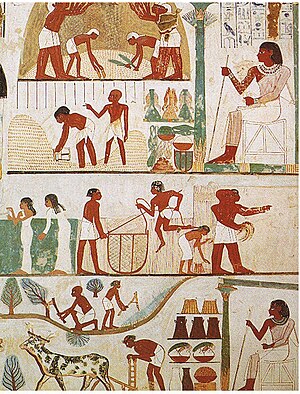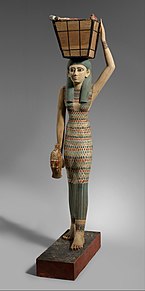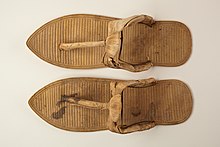Egyptian Fashion 2016 Ancient Egyptian Fashion

The clothing of men and women of several social levels of ancient Egypt are depicted in this tomb landscape from the Eighteenth Dynasty (15th century BC).
Aboriginal Egyptian clothes refers to clothing worn in aboriginal Egypt from the end of the Neolithic menses (prior to 3100 BC) to the collapse of the Ptolemaic Kingdom with the death of Cleopatra in xxx BC. Egyptian clothing was filled with a multifariousness of colors. Adorned with precious gems and jewels, the fashions of the ancient Egyptians were made for not only dazzler but likewise comfort. Egyptian fashion was created to keep cool while in the hot desert.
Elements of Egyptian habiliment

In ancient Egypt, linen was by far the nearly common textile. It helped people to exist comfortable in the subtropical heat. Linen is fabricated from the flax plant by spinning the fibers from the stem of the plant. Spinning, weaving and sewing were very important techniques for all Egyptian societies. Plant dyes could be applied to wear but the wear was usually left in its natural color. Wool was known, but considered impure. Only the wealthy wore animal fibers that were the object of taboos. They were used on occasion for overcoats, but were forbidden in temples and sanctuaries.
Peasants, workers and other people of modest condition ofttimes wore cypher, only the shenti (fabricated of flax) was worn by all people. Slaves frequently worked naked.[1]
The most common headdress was the khat or nemes, a striped cloth worn by men.
Deities
There were several ancient Egyptian deities related to fabrics, clothing and weaving, importantly the god Hedjhotep and the goddess Tayt.[2]
Pharaohs
Purple clothing is particularly well documented, besides as the khat, nemes, and crowns of the pharaohs. The pharaohs would often wear animal skins, unremarkably leopard or king of beasts, equally a sign of their station.[one]
Men
From about 2130 BC during the Old Kingdom, garments were simply constructed. Men wore wrap effectually skirts which were belted at the waist. This style of dress was consequent across grade but higher class Egyptians wore more finely crafted pieces.[iii]
While women's clothing changed during the Middle Kingdom, men's clothing stayed largely static (as evidenced by available art). The two most notable changes were the pleating of the skirts and the adoption of the triangular frock by upper form men. This starched ornamented kilt was held up by a sash and worn over a loincloth.[4]
Artistic relics from the New Kingdom bear witness the largest evolution in men's habiliment. New Kingdom art depicts the use of sheer blouses with intricately pleated sleeves, as well as more than elaborate pleating of the skirts, which themselves had sheer overskirts.[v] Still, only wealthier citizens could afford these materials[6]
Women

Network apparel. Faience, blue and blackness cylinder chaplet, ii breast caps and ii strings of Mitra beads. 5th Dynasty. From burial 978 at Qau (Tjebu), Egypt. The Petrie Museum of Egyptian Archaeology, London

Egyptian woman in a kalasiris
During the One-time, Eye and New Kingdom, aboriginal Egyptian women more often than not wore a simple sheath dress called a kalasiris.[vii] Women'due south clothing in ancient Egypt was more conservative than men's wearable. The dresses were held up by one or two straps and were worn down to the ankle, while the upper edge could be worn in a higher place or below the breasts. The length of the apparel denoted the social form of the wearer.[eight] Beading or feathers were likewise used as an embellishment on the dress.[9] Over the dress, women had a option of wearing shawls, capes, or robes. The shawl was a piece of fine linen material effectually iv feet wide by thirteen or xiv feet long. This was mostly worn pleated as well.
Until the mid-Eighteenth Dynasty women wore a tight-fitting sheath dress, a simple garment that falls from but below the breasts to but to a higher place the ankles, being held upward by two shoulder straps. On statues the straps cover the breasts, merely in painting and relief the unmarried chest depicted in profile is exposed. The apparel hugs the trunk with no slack. Also when women are shown in movement, sitting or kneeling, the wearing apparel still clings to the outline of the body as if elasticated. Withal Egyptian clothes were by and large made from linen, which tends to sag. Surviving dresses consist of a body made from a tube of material sewn up i side, supported non by straps but by a bodice with sleeves. In contrast to dresses shown in fine art, such linen garments tend to exist baggy, and would conceal rather than reveal the trunk.[x]
Children
Children wore no article of clothing until 6 years old. Once they turned half dozen they were allowed to wear wearable to protect them from the dry out heat. A popular hairstyle among children was the side-lock, an unshaved length of hair on the right side of the head. Even though children usually wore no wear, they wore jewelry such as anklets, bracelets, collars, and hair accessories.[11]
Wigs

Painting of a woman with a wig and head cone, circa 1250–1200 BCE
Wigs were worn by the wealthy of both sexes. Made from human hair and sometimes supplemented with date palm fiber, they were often styled in tight curls and narrow braids.[12] For special occasions, both men and women could elevation their wigs with cones of perfumed fat that would melt to release their fragrance and condition the hair.[xiii]
Jewelry

Jewelry was very pop in ancient Egypt, no affair the social grade. It was heavy and rather voluminous. The main reason for wearing jewelry is because of its artful function. The Egyptians were quite soberly dressed in white linen fabrics, and jewelry offered a possibility for contrast.[14] The Egyptian preference was towards the utilise of vivid colors, lustrous stones and precious metals. Gold was won in large quantities in the eastern desert of Arab republic of egypt, simply also came from Nubia, that was an Egyptian colony for centuries.
On the other hand, silver was rare and was imported from Asia. Therefore, it was silverish that was oftentimes considered more precious than gilt. The eastern desert was also an important source for colorful semi-precious stones such as carnelian, amethyst and jasper. In the Sinai were turquoise mines, the deep blueish lapis lazuli had to come from far abroad Afghanistan. Drinking glass and faience (coat over a core of stone or sand) were favorites to replace rocks considering they could be produced in many colors.[15]
The Egyptians became very skilled when making jewelry from turquoise, metals similar gold and silver, and modest beads. Both men and women adorned themselves with earrings, bracelets, rings, necklaces and neck collars that were brightly colored. Those who could not beget jewelry made from gold or other stones would brand their jewelry from colored pottery beads.[16]
One creation that was specific to ancient Egypt was the gorgerine, an associates of metal discs worn on the breast, either over blank skin or over a shirt, and attached in the back.

Ancient Egyptian cosmetic set from c. 1550–1458 BC, featuring, from left to right, a kohl tube, a razor, a pair of tweezers, a whetstone, and a mirror

18th Dynasty sandals, circa 1390–1352 BCE
Cosmetics
Embalming allowed the development of cosmetics and perfumes.[ clarification needed ] The perfumes of Egypt were the virtually numerous, but also the about sought and the costliest of antiquity, which used them extensively. The Egyptians used makeup most of all the ancient people. Nails and hands were painted with henna.
Black kohl, which was used to mark eyes, was obtained from galena. Eye shadow was made from crushed malachite. Ruddy, which was applied to lips, came from ochre. These products were mixed with animal fat to make them meaty and to preserve them. Both men and women wore galena or malachite eyeliner to protect the eyes and enhance their beauty.
Findings were published by American Chemic Order in the journal Analytic Chemistry suggest that the use of lead in makeup was intentional. Findings suggest that the lead in combination with salts produced naturally by the trunk produce nitric oxide which boosts the immune system. Information technology is believed that the production and outcome were intentional. The increase in immune productivity would help to forbid infections like conjunctivitis.[17]
Footwear
Footwear was the same for both sexes. It consisted of coiled sewn sandals of leatherwork, or for the priestly class, papyrus. Since Egyptians were ordinarily barefoot, sandals were worn on special occasions or at times when their feet might get hurt.[8]
Run into also
- Biblical clothing
- Article of clothing in ancient Rome
- Clothing in ancient Hellenic republic
- Article of clothing in the ancient earth
References
- ^ a b "Ancient Egyptian costumes".
- ^ Zecchi, Marco (2001). "The god Hedjhotep". Chronique d'Égypte. LXXVI (151–152): 5–nineteen. doi:ten.1484/J.CDE.2.309159.
- ^ Black, J. Anderson (1980). A History of Way. New York: Morrow. ISBN0688058353.
- ^ Pendergast, Sara (2003–2004). Fashion, Costume, and Culture: Wear, Headwear, Body Decorations, and Footwear Through the ages. Detroit: UXL. ISBN0787654175.
- ^ Strudwick, Helen (2006). Encyclopedia of Ancient Arab republic of egypt. London: Sterling Publishing. ISBN1782744363.
- ^ "Length of Very Sheer Linen Cloth". world wide web.metmuseum.org. The Metropolitan Museum of Art. Retrieved 5 May 2021.
- ^ Tierney, Tom (1999). Ancient Egyptian fashions. Mineola, N.Y.: Dover. p. 2. ISBN9780486408064.
- ^ a b Aboriginal Egypt: Vesture. Reshafim.org.il. Retrieved on 2012-05-05.
- ^ Egypt: Daily Life. sptimes.com
- ^ Gay Robin: Women in ancient Egypt (p. 181-two), British museum press, 1993, ISBN 0-7141-0956-8
- ^ Tierney, Tom. (1999). Ancient Egyptian fashions. Dover. ISBN0-486-40806-X. OCLC 45844704.
- ^ Alfred Lucas et al., Ancient Egyptian Materials and Industries. Dover, 1934. p. 30-one.
- ^ Chaudhri, S, Asian Journal of Pharmaceutics (Jul 2009), p. 164
- ^ Sims, Lesley (2000). "Clothes & fashion". A Company'southward Guide to Ancient Egypt . Saffron Hill, London: Usborne Publishing. pp. 52–53. ISBN0-7460-30673.
- ^ – Ancient Egyptian Jewelry. Dr. Maarten van Raven, Curator Archaeological Museum, Leiden, the Netherlands 2016-01-02. Retrieved on 2016-03-17.
- ^ Clothing – Ancient Egypt Archived 2017-01-08 at the Wayback Machine. Historyonthenet.com (2010-04-xxx). Retrieved on 2012-05-05.
- ^ "Cleopatra's Heart Makeup Warded Off Infections?" nationalgeographic.com Retrieved on 2012-05-05.
0 Response to "Egyptian Fashion 2016 Ancient Egyptian Fashion"
Post a Comment